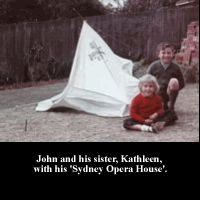Art Must
Be More Than Purely Visual
Because art
must be more than purely visible, my work addresses the following issues:
Suggested
reference books are listed at the end of the
page.
The
Hidden Meaning of Architecture
Architecture is more than just a place of habitation.
Architecture is the manifestation of a culture's creation myth and worldview.
The early house forms of the Anasazi of the American southwest are referred
to as pit houses. These were houses that were half dug into the ground.
Over time, the houses were built more on the surface of the ground,
culminating in the cliff houses typically found at Mesa Verde and Chaco
Canyon. At the same time as the habitation houses were emerging from
the ground, the form of the Kiva, the ceremonial house consisting of
a cylindrical chamber dug into the earth with an entrance in the center
of the roof, was evolving.
Therefore, the original pit house form evolved into two distinct forms:
an inhabited cliff house, and a ceremonial Kiva. Thus the Kiva, as an
evolution of the pit house, is more than a dwelling; it reflects the
origins of the Anasazi culture.
Similarly, Dogon men meet beneath a structure called a Togu Na. This
is a structure consisting of a series of external columns, covered with
a roof of maize stalks. This reflects the origin myth of the Dogon,
whose forebears rested beneath a cattle-feeding manger of the same form.
Thus, the Togu Na reflects and therefore reinforces the origin of the
culture.
The
Subject / Object Dichotomy
Inherent in sculpture is the issue of object vs. subject.
As a manufactured item, a sculpture is first and foremost an object
because it occupied space. But sculptures are invariably about something.
This something is their subject, which sets the frame of reference and
the context. The issue of sculpture is the uneasy fight for dominance
of object or subject.
The work of Richard Serra represents object. His sculpture exists as
object; it is self-referential. The sculpture of Degas represents the
opposite pole. Degas's sculpture exists as a reference to something,
i.e. the subject.
In my work, I play with this dichotomy of the existence of sculpture.
I aim to produce sculpture that is subject but which on closer inspection
is object, and vice versa. That is the reason for my choice of steel
as a medium, for it has no inherent or assumed subject.
Interestingly, it is people unfamiliar with art, and especially children,
who see both the subject and the object in my work. Children still possess
that sense of imagined potential when they observe something. For a
child, a box can be a car, or a boat, and yet it still remains a box.
They do not have the conflict of perception that we adults possess.
Art
as a Process of Making
I believe that the interaction between the artist and
the material is an essential part of the development of the object.
My education in architecture stressed a strong separation between the
intellectual act of design and the physical act of fabrication. This
codifies a class distinction that I cannot accept. For me, the great
joy of sculpture is the actual making of art, for I find the physicality
of my material very satisfying.
All of my work is welded using an electric welder. Other types of welders
would give a better finish, but these methods lack the rough physically,
and remove the 'sense of hand'. Likewise, steel is a material that has
no noble pretensions, and the act of fabricating steel is first and
foremost labor. However, I do accept the irony of the situation. I fabricate
steel as a luxury. Any person who welds steel for a living would not
possess such a romantic view of the material.
Click
Here for an example of a work in progress.
Click
Here to see my working process.
Click
Here for my scrapbook.
Levels of Knowledge
In a small-scale culture, a child knows that a
mask is actually the spirit that it represents. At each stage
of initiation into manhood, progressively more knowledge is gained
about the object. However, it never becomes purely a mask, not
even to the maker.
My sculptures are derived from this concept of levels of knowledge.
Initially, the sculptures may appear as abstract forms. To someone
familiar with the subject matter, the forms are known. The person
aware of the subject matter (often identified by the title) may
think that they know the significance. However, as always, it
is only the maker of the object who knows the truth or otherwise
of the piece. For it is they who know what is revealed and what
is withheld.
References
Andrews, Lew. Story &
Space in Renaissance Art: The Rebirth of Continuous Narrative.
Cambridge University Press. September 1998. ISBN:
0521646634
Dewey, John. Art As Experience.
Berkley Publishing Group. March 1959. ISBN: 0399500251
Elsner,
Jas. Art and the Roman Viewer: The
Transformation of Art from the Pagan World to Christianity. Cambridge
University Press. February 1977. ISBN: 0521599520
Humphrey, Caroline and Vitebsky, Piers. Sacred
Architecture. Little Brown, 1997. ISBN: 0316381225
McNaughton, Patrick, R. The Mande Blacksmith:
Knowledge, Power and Art in West Africa. Indiana Univ Pr.
April 1998. ISBN: 025333683
Rapoport, Amos. House Form & Culture. Prentice Hall. February
1969. ISBN: 0133956733
Tucker, William. Language of Sculpture. Thames & Hudson.
September 1985. ISBN: 0500271046
Tufte, Edward R. Visual Explanations: Images and Quantities,
Evidence and Narrative. Graphics Press. January 1997. ISBN:
0961392126
|
